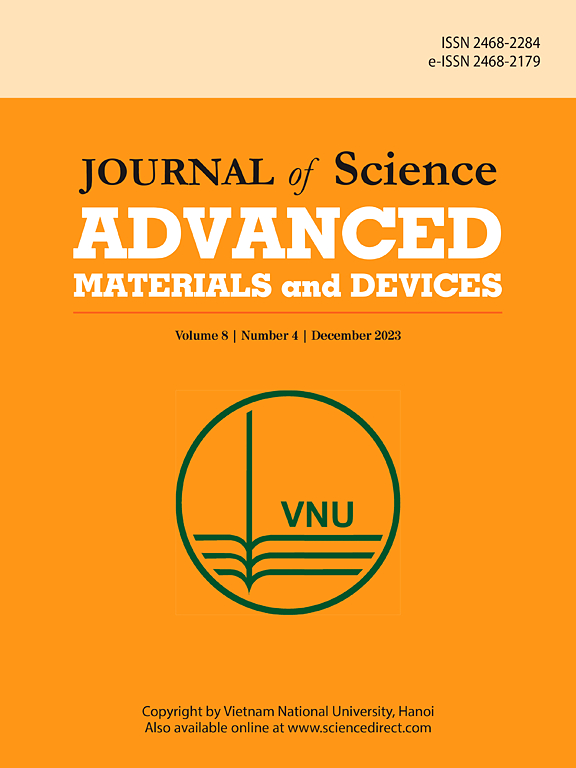Shape anisotropy-induced local incoherent magnetization: Implications for magnetic sensor tuning
IF 6.7
3区 材料科学
Q1 MATERIALS SCIENCE, MULTIDISCIPLINARY
Journal of Science: Advanced Materials and Devices
Pub Date : 2025-04-21
DOI:10.1016/j.jsamd.2025.100893
引用次数: 0
Abstract
The geometry of magnetoresistive sensors based on thin magnetic films plays a crucial role in shaping their magnetization behavior and overall performance. This study investigates Wheatstone bridge sensors made with NiFe single-layer films (thickness: 10–40 nm; width: 20–60 μm; length: 500 μm) to analyze the impact of shape anisotropy on magnetization distribution. We observed domain images and sensor signals by applying a magnetic field with a constant direction and strength while varying the strength of a second magnetic field applied perpendicularly to the first. Wide-field Kerr microscopy revealed that magnetization reversal occurs locally and incoherently, with the degree of incoherence increasing in geometries with stronger demagnetizing fields. The demagnetizing field in rectangular-shaped thin films was calculated, revealing a sharp increase in field strength 3–4 μm from the bridge element edge when magnetized in the short-length direction, which results in localized magnetization behavior. The sensor signals were calculated and measured for various width-to-length ratios of the bridge elements and external magnetic field strengths. Results show that variations in sensor geometry and external magnetic fields can influence peak-to-peak voltage by up to 41 % and make significant hysteresis in the sensor signal. These findings provide valuable insights into optimizing the design and performance of magnetoresistive sensors for advanced applications.
形状各向异性诱导的局部非相干磁化:磁传感器调谐的意义
基于磁性薄膜的磁阻传感器的几何形状对其磁化行为和整体性能的形成起着至关重要的作用。本文研究了用NiFe单层薄膜(厚度:10-40 nm;宽度:20-60 μm;长度:500 μm),分析形状各向异性对磁化分布的影响。我们通过施加一个方向和强度恒定的磁场,同时改变垂直于第一个磁场的第二个磁场的强度,来观察域图像和传感器信号。宽视场Kerr显微镜显示,磁化反转发生在局部且不相干的情况下,随着退磁场的增强,几何形状的不相干程度增加。计算了矩形薄膜中的退磁场,发现在短长度方向磁化时,从桥单元边缘处的场强会急剧增加3 ~ 4 μm,导致局部磁化行为。对传感器信号进行了计算和测量,测量了桥单元的不同宽长比和外部磁场强度。结果表明,传感器几何形状和外部磁场的变化可以对峰值电压产生高达41%的影响,并在传感器信号中产生明显的滞后。这些发现为优化先进应用的磁阻传感器的设计和性能提供了有价值的见解。
本文章由计算机程序翻译,如有差异,请以英文原文为准。
求助全文
约1分钟内获得全文
求助全文
来源期刊

Journal of Science: Advanced Materials and Devices
Materials Science-Electronic, Optical and Magnetic Materials
CiteScore
11.90
自引率
2.50%
发文量
88
审稿时长
47 days
期刊介绍:
In 1985, the Journal of Science was founded as a platform for publishing national and international research papers across various disciplines, including natural sciences, technology, social sciences, and humanities. Over the years, the journal has experienced remarkable growth in terms of quality, size, and scope. Today, it encompasses a diverse range of publications dedicated to academic research.
Considering the rapid expansion of materials science, we are pleased to introduce the Journal of Science: Advanced Materials and Devices. This new addition to our journal series offers researchers an exciting opportunity to publish their work on all aspects of materials science and technology within the esteemed Journal of Science.
With this development, we aim to revolutionize the way research in materials science is expressed and organized, further strengthening our commitment to promoting outstanding research across various scientific and technological fields.
 求助内容:
求助内容: 应助结果提醒方式:
应助结果提醒方式:


